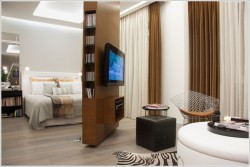Just because a room lacks a lot of natural light does not mean that you need to be in a dark room around the clock. Believe it or not, this is a pretty common dilemma that top interior designers will solve forever. An extensive renovation can certainly correct the problem. Luckily, this is not the only option you have. There are proven decor tricks that designers rely on to lighten a dark room.
A well-lit room is not only more inviting - it can also improve overall well-being. A bright, airy home can help boost your mood and reduce your stress levels. In order to transform your home into a light-filled oasis, we have put together some of our favorite footage. From adding basic accessories to retrofitting ceilings or hardwood floors, you can consider various options to make your home feel sunnier and more inviting.

If an all-neutral room is not your style, there's no need to worry. Going for a bold accent wall and a palette of daring hues, like this design by Mary McDonald, can energize a room and make it appear brighter.

One of the best ways to bring more light into a room is with a high-gloss paint color, and a ceiling is the perfect spot to experiment with this design choice. A glossy ceiling finish reflects light well, and it adds an unexpected element to a room.

When a space is in need of additional light, it's best to choose light wood flooring to brighten up the room. Light stains are also perfect for high-traffic areas since they're better at masking scratches.

A large, colorful area rug is not just a solution for defining a specific area in a home. It can also be used to inject personality into a room and show off your aesthetic.

Double the amount of sunlight in your room by allowing it to bounce off reflective surfaces. Hang a large mirror directly across from the largest window in your room, or arrange an array of smaller mirrors to help brighten a dark staircase, suggests Houzz.

There are plenty of window treatment options on the market that provide privacy without turning your abode into a vampire's lair. Get rid of heavy, dark curtains that absorb light, and instead opt for translucent shades that allow sunshine to spread throughout the room.

Incorporating shimmery gold or silver accessories is an easy way to transform a dark and dreary space. The simple addition of a metallic mirror, light fixture, piece of artwork, or even a decorative object has a way of reflecting light and making a design scheme feel more luxurious.

If light can't reach your window, it certainly won't brighten your room. Make sure any bushes or trees cushioning your windows are trimmed regularly, and avoid planting trees on the southern side of your home (as Scandinavian Home Staging explains, the sun will be too high for the trees to provide shade in the summer, and in the winter, the foliage will block your windows from solar warmth).

It may seem counterintuitive, but glossy walls can create glare (rather than reflect light equally). Matte surfaces, on the other hand, reflect light in every direction.

Yes, we know. This one seems a tad obvious, but simply cleaning your windows can have a major effect on how much sunlight streams into the room. The less dirt, dust and splatters on your windows, the more sunshine can peek into your room. (Plus, cleaning a window is way easier than installing more windows.)

Carefully think about where you place light fixtures throughout your space. The New York Times reports that indirect lighting aimed upward (say, a torchiere floor lamp at the back of the room) can make up for lack of light on the ceiling as daylight dwindles.

You love your art—but do you love it more than a healthy dose of Vitamin D? Save your large, dark artworks for rooms that aren't short on light. If you cover a wall with paintings or posters, they will absorb the little sunlight streaming into your space rather than reflect it.

Bookshelves or partitions should never be parallel to a window, or they'll obstruct the light. Carefully consider the flow of daylight and how you want to promote it.

This isn't the place to try out a moody, dark color palette. Think back to 6th-grade science: The lighter the color of your walls, the more light they'll reflect. If your walls are neutral, paint the ceiling a shade lighter to help light bounce around the room.

While you don't want to go glossy on the walls (remember: glare), reflective surfaces can play to your advantage when it comes to bouncing light. For a room with limited sunlight, opt for glimmering items like acrylic accents, translucent furniture, and mirrored surfaces such as reflective coffee tables.
 10 House Designs for Small Spaces
10 House Designs for Small SpacesIf you have a small space interior and you wonder how c...
 Top 10 Beautiful Bathrooms From Around The World
Top 10 Beautiful Bathrooms From Around The WorldTo most, the bathroom is considered to be one of the mo...